Middle or low water pressure direct spiral double helix converging nozzle structure optimization and flow field analysis①
Jiang Lin (蒋 林), Wu Ruolin, Zhao Hui
(College of Machinery and Automation, Wuhan University of Science and Technology, Wuhan 430081, P.R.China)
Middle or low water pressure direct spiral double helix converging nozzle structure optimization and flow field analysis①
Jiang Lin (蒋 林), Wu Ruolin, Zhao Hui②
(College of Machinery and Automation, Wuhan University of Science and Technology, Wuhan 430081, P.R.China)
In order to solve the problem of using middle or low water pressure to form fine water mist, a new nozzle is proposed in fire rescue robot. Existing water mist nozzles are basically used for high pressure and in large size, complex structure and poor low pressure atomization effect in comparison with requirement of snake-like fire rescue robots. On the basis of comprehensive typical spray nozzles, a direct spiral double helix converging nozzle (DSDHCN) is proposed, which has the advantages of small volume, light weight, simple structure, and convenient installation. To make the spray nozzle have good performance, and meet the requirements of more efficient fire extinguishing, a numerical study is carried out to analyze the internal and external full flow field of nozzle. A gas-liquid two-phase flow is applied to simulate the external full flow field of nozzle with VOF model in fluent software. The simulation results show the real situation of water flow out of the atomization nozzle and the water jet trajectory. Some simulations about middle or low water pressure direct spiral double helix converging optimized nozzle have been done in 30bar pressure. The simulation results show that the optimized nozzle structure not only makes the spray droplets have a good cone angle, but also have a sufficient axial velocity,which proves the structure rationality of the proposed optimized nozzle.
direct spiral double helix converging nozzle (DSDHCN), internal and external flow field analysis, structure optimization, water mist
0 Introduction
A water mist fire extinguishing system has the advantages of advanced mechanism, high extinguishing efficiency, safety, no harm, no pollution and no damage to the equipment, etc., so it is believed as an ideal alternative for the halon fire extinguishing system.
In China, Sichuan Eastbourne Air Fire Equipment Company Limited, Nanjing Fire Equipment Company Limited, Zhejiang University, Huazhong University of Science and Technology, China University of Science and Technology have done some researches in the pure water pressure mist fire extinguishing technology[1].
In the pure water pressure mist fire extinguishing system, the nozzle is one of the most important components. The performance of water mist nozzle directly affects the quality and extinguishing effect of water mist. Numerous studies have been carried out to investigate the performance of water mist nozzle in the water mist fire extinguishing system. Italy PNR Spray Systems Company introduced a combined nozzle, which consisted of six peripheral sprinkler heads and a center sprinkler head[2]; Cuba Germán Ferreira designed a kind of two-fluid atomizer nozzles, which opened in the airflow hole inside, airflow made high speed water flow pass through the nozzle and atomized[3].
Scholars in Southwest Jiaotong University designed a straight-through swirling low pressure liquid atomization nozzle, which body and screw formed a spiral flow channel to turn the rotary flow rotate at high-speed within the nozzle, and then formed a spray[4]. Scholars in Northeastern University made the simulation of a direct spiral nozzle[5]. Scholars in Dalian Maritime University developed multi-nozzle combination high-pressure water mist nozzles. The nozzle is a combination of more than three types tangential slot water mist nozzles, which increases radial momentum and spray angle of water mist, and water mist has a wide covering range[6]. The main types of include nozzle pressure atomization nozzles, rotary atomization nozzle, air atomization nozzle[7], ultrasonic or whistle atomization nozzle[8]. But the research about combining the advantages of pressure atomization nozzle and rotary atomizing nozzle is scarce[9]. From the hydraulic nozzle situation at home and abroad, it is found that most of the nozzles are used in high pressure and large flow situation, which leads the flow field in two-phase. Compared with middle and low pressure atomization equipment, these high pressure equipment are in heavy large volume, complicated structure, not applicable. Therefore a low pressure direct spiral nozzle was investigated, but convergence was not considered. There was high energy consumption in the export, the radial velocity of flow was small, the atomization effect was not ideal in the nozzle. So a DSDHCN is proposed.
1 Atomized nozzle design
1.1 Water mist fire extinguishing principle
Different from the traditional water spray way for fire extinguishing, a water mist fire extinguishing system is to allow water media to pass through a special nozzle to atomize the water to form small droplets particles in a special method. Atomized droplets can not only play the role of cooling, suffocation, isolated radiant heat, dilution, but also quickly vaporize and absorb a lot of heat, quickly reduce the surface temperature of the flame, meanwhile atomized droplets at high speed jet status penetrate flame, improve the efficiency of firefighting. The volume of water after atomization and endothermic will be a sharp increase, dilute the oxygen near fire, separate the fire from the air, play the role of fire suffocation, meanwhile limit the outward transfer of fire and heat radiation sources. Water mist can absorb smoke and toxic gases which have a fatal effect on the human body, and reduce injury to people[10].
1.2 Droplet atomization mechanism and process
Droplet deformation and crushing are the important processes of droplets atomized, the substance of mist is that the nozzle makes atomization mist crush into small droplets particles in a special method. The crushing process of droplets is very complex, and the principle is the struggle between the droplet surface tension, viscous and the external force. Under the effect of surface tension, droplet maintains a spherical state, and sticky can prevent droplets from being deformed. When the external force is sufficient to overcome the surface tension and viscosity of the droplets effect, droplets will be broken to form a large number of small droplets particles. When the external force is insufficient to overcome the surface tension and viscosity of the droplets effect, droplet will remain spherical state or deformation. Small droplet particles formed in the external force are also unstable, they will be broken again in the flow of external force and undergo secondary atomization process: further break into smaller droplets particles. In theory, in a certain range, the smaller the diameter of the small droplet particles is the better the fire extinguishing effect will be.
The instability state of dynamics leads to liquid film breakup into droplets. Under the effect of surface tension instability mechanism, water droplets crush into water mist. Pressure atomizer nozzle is the most common type of nozzles. The pressure is critical to the nozzle atomization effect.
1.3 Water jet beam break theory
The process of water atomization in the nozzle, in essence, is the process of the water jet beaming into the air and is broken into droplets under the effect of air resistance. The water under the action of the surface tension and viscosity will maintain a stable spherical. According to the mechanism of water droplets broken, there are competition between air resistance and the surface tension & viscosity. The air resistance will determine whether the water droplets break or not and the degree of water droplets broken.
The density of water stream is ρ, the speed of water stream is v, the sectional area of the nozzle is A. The water stream is emitted from the nozzle. At time t0, injection water quality is
m=ρ·v·A·t0
(1)
The process of water injection into the air meets the law of conservation of momentum and it is assumed that the flow of air resistance is at the value of F. According to the law of conservation of momentum:
m·v=F·t0
(2)
By Eqs(1) and (2), the following can be obtained:
ρ·v·A·t0·v= F·t0
(3)
Namely
ρ·v2·A=F
(4)
It is clear in Eq.(4), F is related to the nozzle jet velocity and nozzle cross-sectional area. When the cross-sectional area value remains constant, the air acting on water flow resistance F is proportional to the square of water flow velocity v. The following conclusions can be got: the resistance of air acting on water flow increases with the increasing of speed of the water flow jet however when the speed increases to a certain extent, air flow resistance is sufficient to overcome the surface tension and viscosity, at this point the water will be broken into small droplets under the action of air resistance. As the increasing of the velocity of the water flow jet continues, water flow will be broken up into smaller droplets, thus atomized into small droplets particles. In theory, the greater the speed is, the higher the degree of atomization is.
1.4 Atomization nozzle type
The process of water atomization is complicated, which involves numbers of areas of knowledge of fluid mechanics, aerodynamics, two-phase fluid dynamics, and there are many water atomization methods. The main types of nozzles are just as followings in Refs[11,12]: pressure atomization nozzle; rotary atomization nozzle; pneumatic atomization nozzle; ultrasonic or whistle atomization nozzle.
In this paper an atomization nozzle is designed which combines the advantages of pressure atomization nozzle and rotary atomization nozzle, not only the liquid atomized by pressure, but also the way of using rotation centrifugal increases water flow centrifugation.
1.5 Water pressure servo snake-like fire rescue robot atomization nozzle structure
The fire extinguishing equipment of water pressure servo snake-like fire rescue robot requires small size, light weight, simple structure, easy installation and good atomization. Small water mist nozzle atomization performance has a direct impact on its extinguishing effect. Good atomization characteristics both conserve water and extinguish fire quickly and effectively. Because of water pressure servo snake-like fire rescue robot is not only driven by water pressure but also small water mist fire extinguishing, in order to reduce costs and simplify the system structure, the drive and fire extinguishing systems are combined into a system. Therefore, direct screw convergent nozzle device is used to achieve low pressure water flow atomization fire extinguishing, and the working pressure is 30bar.
According to the principle of droplets broken atomization, appropriate cross-sectional area of the nozzle outlet is selected to improve the speed of the jet stream to be helpful for water flow atomization. Small water mist atomization effect is determined by the speed of the water flow at the outlet, the velocity includes axial velocity and centrifugal velocity. Axial velocity makes the interaction of water flow and air become intense, and air force which is greater and damags balance easily makes it easy for water flow atomization; Centrifugation speed becomes large so that the edge water film of water flow generates larger centrifugal force, which can also disrupt the balance so that the water splashes out, breaks into tiny droplets. In view of this, this paper presents a middle or low pressure direct spiral double helix converging nozzle to increase the speed of water flow axial and centrifugal velocity, the structure is shown in Fig.1.

1—central jet orifice 2—under spiral bevel 3—inner cone angle
The direct spiral double helix converging nozzle consists of three parts of nozzle body, upper spiral bevel and under spiral bevel. The nozzle body is conical. Its upper is water inlet, and upper external is screw thread, connecting with the water pipe connector. The inner of upper part is a straight hole, lower part is tapered hole convergence. The bottom has a nozzle hole, water emits from the nozzle hole through the outer cone angle, and finally into the air.
A central jet orifice is set at the center of the upper spiral bevel and two semicircle spiral channels are set at its periphery. Under the spiral bevel is hollow with two semicircle spiral channels set at the inner edge. The upper spiral bevel and under spiral bevel match each other to form two complete circle spiral channels. Circle jet orifice and two circle spiral channels join together at the bottom of the under spiral bevel.
The structure can ensure that the flow has enough rotational momentum and axial momentum. The same direction of nozzle inlet、central jet orifice and jet direction can ensure the axial velocity. The spiral channel could generate larger centrifugal force, which could increase centrifugal speed of the flow. The circle cross section of spiral channel could reduce friction loss.
2 Internal and external flow field analysis and structure optimization of DSDHCN
2.1 Internal flow field FLUENT model for DSDHCN
While taking a simulation of nozzle by using Fluent simulation software, this paper does the following assumptions: energy loss could be neglected while it is very little in the nozzle internal flow; compared with other force the liquid surface tension is small, hence liquid surface tension could be neglected; the energy exchange between objects is not considered and the water in nozzle is incompressible[13].
2.1.1 Meshing
3D model of the spray nozzle is shown in Fig.2(a). The object of this paper is to investigate the characteristic of water in spray nozzle. Therefore, 3D model of internal flow field which is firstly established using PRO/E software is shown in Fig.2(b).
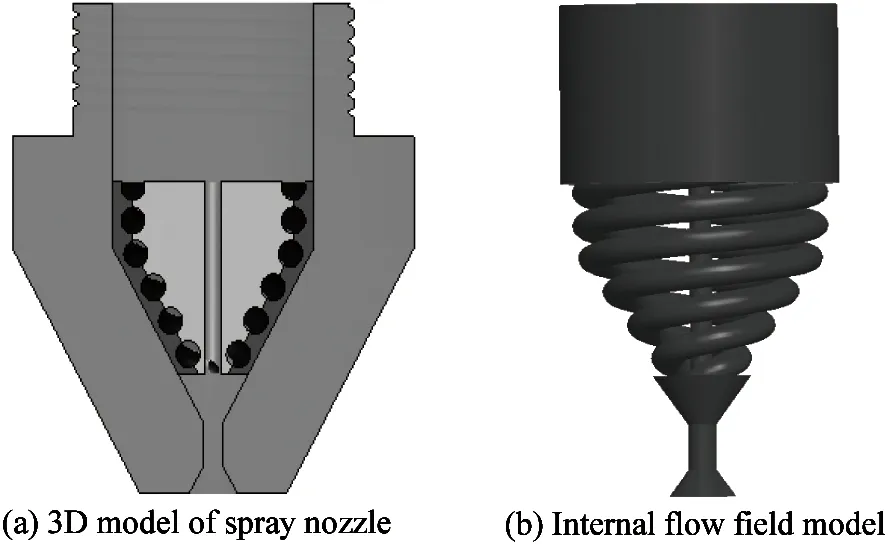
Fig.2 3D model of spray nozzle(DSDHCN) and its internal flow field
The internal flow field of spray nozzle is meshed by Gambit which is the pre-treatment function of Fluent software. Simulation will use volume meshing automatically generated by Gambit.
Gambit automatically generates various grids, including tetrahedral, hexahedral, pyramidal and wedge. Common types of grids: regular structure grid (Map), a block-structured grid (Submap), non-structured mesh (Cooper), hybrid grid (TGrid). TGrid grid is used in this paper. The TGrid grid of DSDHCN is shown in Fig.3.

Fig.3 Meshing of nozzle internal flow field
2.1.2 Choice of turbulence model
Water at the entrance of nozzle enters the nozzle with jet form, but under the action of spiral channel, internal flow field of nozzle is spiral. Thus the standard k-ω model is selected. The standard k-ω model contains the influence of low Reynolds number, the compressibility effects and shear flow diffusion. The standard k-ω model is suitable for wake flow, mixer layer, jet, wall limited flow, attached boundary layer turbulence and shear flow diffusion[14].
2.1.3 Parameters and boundary conditions setting
The internal flow field of the nozzle is single-phase continuum flow, the medium is water, the density of water is 1000kg/m3, and the standard k-ω model is used to do numerical simulation. Assuming that no air is in the water flow and the gravitational acceleration is 9.81m2/s, the direction along with the axial direction of nozzle outlet is positive. Boundary conditions setting is shown in Fig.4.
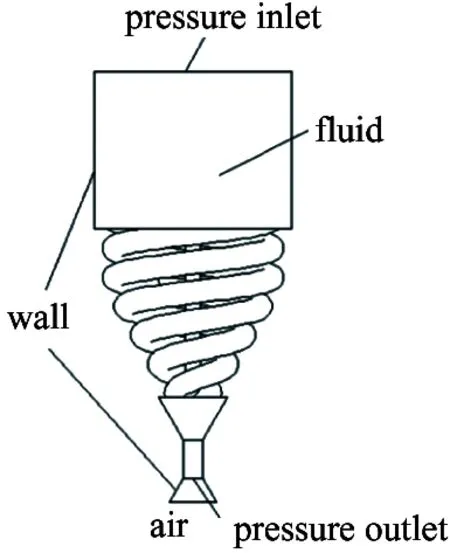
Fig.4 Boundary conditions setting
Choosing the nozzle entrance as the pressure inlet, and pressure is 30bar. The nozzle outlet is pressure outlet and because of direct injection to the air the pressure is standard atmosphere pressure with the value of 1.01325bar,the rests are set as static wall. In the residual setting device, all residual accuracy is taken a default value of 10-3. When residual values are less than 10-3, and the quality of import and export flows is equal, or the error is less than 0.5%, it reveals the convergence of the simulation.
2.2 Effect of nozzle structure and key parameter on nozzle atomization performance
2.2.1 Effect of central jet orifice on nozzle atomization performance
In order to analyze the influence of central jet orifice on nozzle atomization performance, a model is compared and analyzed with central jet orifice or without central jet orifice.
The axial section velocity contouring about the internal flow field of nozzle with central jet orifice is shown in Fig.5(a). The axial section velocity contouring about the internal flow field of nozzle without central jet orifice is shown in Fig.5(b).
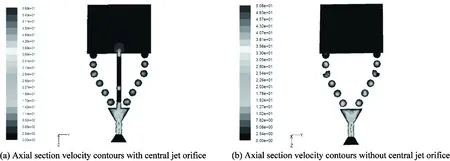
Fig.5 The axial section velocity contours of the internal flow field of nozzle
According to Eq.(4), the flow velocity of nozzle outlet directly affects nozzle atomization performance and the higher velocity the better performance. As can be seen in Fig.5(a), the flow velocity increases while water enters the spiral channel and the central jet orifice, and reaches a maximum value at the nozzle outlet. Meanwhile, in the same horizontal plane(radial plane), the flow velocity in central jet orifice is higher than in the spiral channel; As can be seen in Fig.5(b), the flow velocity increases while water enters the spiral channel and also reaches the maximum value at the nozzle outlet.
The axial section velocity distribution about the internal flow field of nozzle with central jet orifice is shown in Fig.6(a). The axial section velocity distribution about the internal flow field of nozzle without central jet orifice is shown in Fig.6(b).
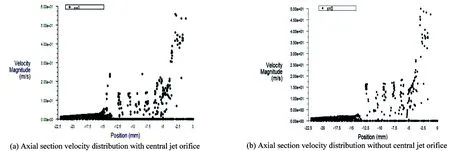
Fig.6 Axial section velocity distribution of the internal flow field of nozzle
As can be seen in Fig.6(a), the flow velocity increases slowly before the water enters central jet orifice and spiral channel. While the water enters the channel, the flow velocity increases obviously. In the central jet orifice and spiral channel, the flow velocity continuously increases by the screw centrifugal force. Because three channel flows counteract each other, in the inner cone namely the intersection of three channels the flow velocity decreases obviously. The flow velocity increases intensely while water enters the nozzle orifice and reaches the maximum value 56.83m/s at the nozzle outlet; As can be seen in Fig.6(b), the flow velocity changing process is the same as the changing process shown in Fig.6(a). However, without the central jet orifice, the flow velocity is smaller than the flow velocity in the situation with central jet orifice with the value of only 50.82m/s at the nozzle outlet. As can be seen, the flow velocity will be improved while the nozzle has central jet orifice, which has positive influence on nozzle atomization performance.
2.2.2 Effect of diameter size on nozzle atomization performance
The flow velocity increases under the action of pressure along with the water enters the nozzle. The water jets from the nozzle outlet, enters into the air, and gets atomization under the action of air resistance. The diameter size of nozzle orifice directly affects the nozzle atomization performance. In order to study the impact of nozzle orifice diameter on nozzle atomization performance, this paper simulates and analyzes nozzles which have central jet orifice with different diameter sizes. Three diameter size 0.8mm, 1mm and 1.2mm are selected for nozzle orifice, and the diameter sizes of central jet orifice and nozzle orifice are the same. The results of simulation are shown in Fig.7, Fig.8 and Fig.9.
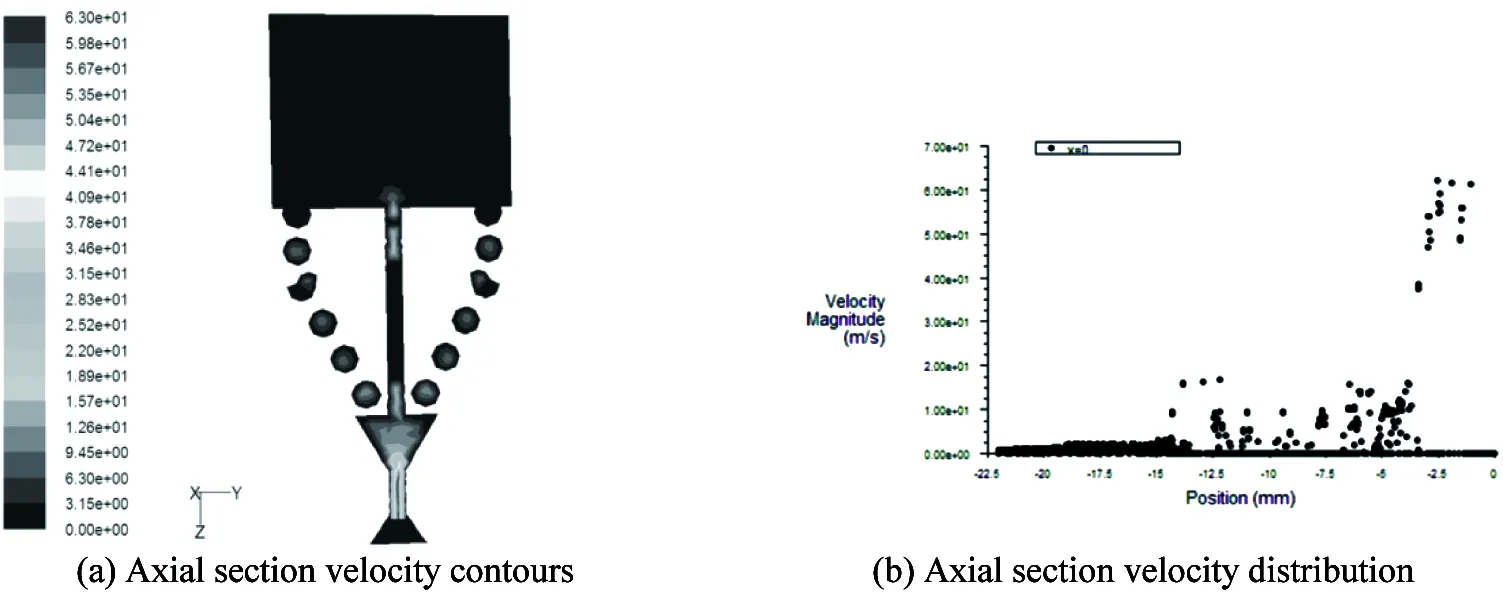
Fig.7 The internal flow field with 0.8mm nozzle orifice

Fig.8 The internal flow field with 1.0mm nozzle orifice

Fig.9 The internal flow field with 1.2mm nozzle orifice
Comparing and analyzing Fig.7, Fig.8 and Fig.9, it is obvious that, when central jet orifice diameter and nozzle orifice diameter are both 0.8mm, the maximum internal nozzle speed is 162.97m/s; when central jet orifice diameter and nozzle orifice diameter are both 1mm, the maximum internal nozzle speed is 56.75m/s; when central jet orifice diameter and nozzle orifice diameter are both 1.2mm, the maximum internal nozzle speed is 54.22m/s.
It is found that too small size of the central jet orifice diameter will lead lager damping on the water, which goes against fire fighting. On the other hand, too big diameter is not conducive to atomization, and if the diameter is too small, it will lead to small water flow. Therefore, taking a comprehensive consideration, it performs better when central jet orifice diameter and nozzle orifice diameter are both 1mm.
2.3 The internal flow field analysis of the nozzle
Compared with the results of simulations above, a better atomization can be gained when there is a direct central jet current orifice on the nozzle. The atomization spray nozzle has the optimal atomization performance and flow characteristics when the direct central jet current orifice and the nozzle outlet are of the same diameter 1mm.
Now the atomization spray nozzle having spiral channels and a direct central jet current orifice whose diameter is 1mm, same to the nozzle outlet are selected, for internal flow field simulation.
The getting knowledge of the flow field inside the nozzle is very important to further optimize the nozzle and the research on its atomization mechanism.
Fig.10 plots the contour of pressure of the flow field inside the nozzle. From the figure it can be seen that, the water pressure decreases when the water jet is in the direct central jet current orifice and spiral channels, when the three flows meet at the inner cone, pressure increases, while the flow is in the nozzle outlet, the pressure decreases. At the nozzle outlet in the flow field, the water pressure is minimum, and the flow speed is maximum.

Fig.10 The pressure contour of the nozzle internal flow field
Fig.11 plots the velocity vector of the nozzle internal flow field. The water vector velocity increases when it is in the direct central jet current orifice and spiral channels, when the three flows meet at the inner cone, the speed decreases due to their interaction. The speed increases sharply at spiral channels entrance, where the vector velocity is the maximum in the nozzle internal flow field, reaches 66.07m/s, and then decreases after the water flows into the nozzle.
Fig.12 shows the path line of a nozzle from the inlet to the outlet, it’s obvious from the figure that the trajectory is disordered before the water jet enters the direct central jet current orifice and spiral channels,which indicates that the turbulence generated in this part, and the turbulence phenomenon is more serious at the inlet of spiral channels entrance than at the inlet of the direct central jet current orifice. After the water jet is in the direct central jet current orifice and spiral channels, the trajectory becomes smoother. This indicates that the water flows smoothly along the waterways, and there is no generation of turbulence.
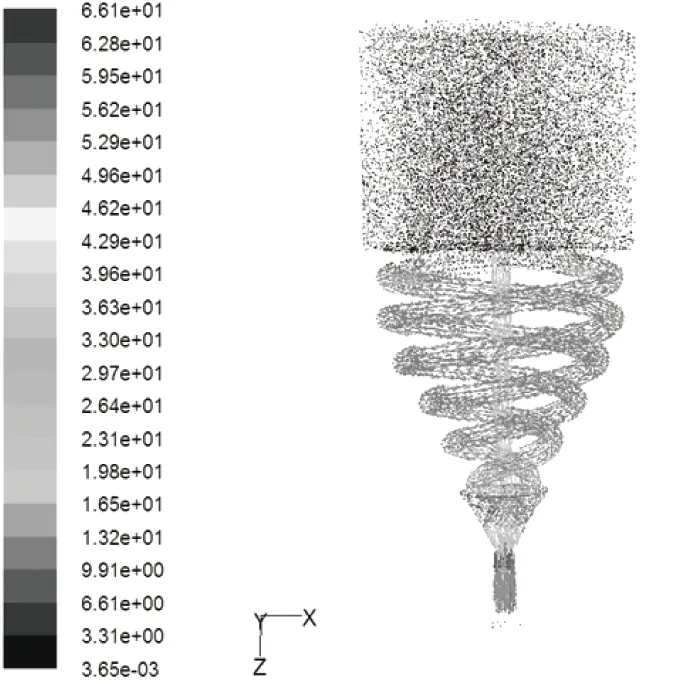
Fig.11 The velocity vector contour of the nozzle internal flow field

Fig.12 The path line of a nozzle from the inlet to the outlet
2.4 The model of the nozzle internal flow field and analysis
In the jet model of the nozzle, there is obvious stratification between the water and the air flow, and the two fluids would not be mixed. Therefore, the jet model of VOF (volume of fluid) is appropriate. This jet model of the nozzle is about the research on the nozzle opening, so k-ε double equation model proposed by Jones and Laud is proper.
2.4.1 Model of the nozzle full flow field
The model of the nozzle full flow field is shown in Fig.13.
2.4.2 Meshing and parameter settings
Meshing, boundary setting and parameter settings in Fluent are identical with the previous section. Fig.14 is the grid pattern after the modeling is imported into Fluent.

Fig.13 Model of direct double helix convergent nozzle and spray field

Fig.14 Meshing of direct double helix convergent nozzle and spray field
2.4.3 Atomization process and results analysis
It can be seen from the following Fig.15 that bifurcation phenomenon is appearing at any time including three branches: the upper, below and the middle. The upper and the below one eventually form a hollow cone, so that the density of droplets at the surface of the cone is larger, the middle one is a direct type just filling the hollow part, and the effect is very good for fighting the fire. Below is the velocity path line of direct spiral double helix converging nozzle.

Fig.15 The velocity path line of DSDHCN
It’s easy to see from Fig.15 that the branch phenomenon is obvious, and the atomization effect is good, the cone angle is about 60°, and the velocity of droplet is about 32m/s, in line with the requirements of robot fire extinguishing.
3 Conclusions
Comparing the simulations of flow field simulated by Fluent software, the structure of direct spiral double helix converging nozzle performs better in atomization. the results shows that the structure of direct spiral double helix converging nozzle not only ensures a nice taper angle of droplets but also makes droplets have enough axial velocity, which indicates that the structure of direct spiral double helix converging nozzle is suitable for the water pressure snake like fire rescue robot.
[ 1] Deng Q L, Wan H X. Discussion on high- pressure water mist fire extinguishing technology and applications. Private Technology, 2013,(4): 57-57
[ 2] Santangelo P E. Characterization of high-pressure water-mist sprays: Experimental analysis of droplet size and dispersion. Experimental Thermal and Fluid Science, 2010, 34:1353-1366
[ 3] Germán F, Juan G, Félix B, et al. Design optimization of twin-fluid atomizers with an internal mixing chamber for heavy fuel oils. Fuel Processing Technology, 2009,90: 270-278
[ 4] Liu Z C. Straight swirl mist nozzle atomization theoretical analysis and extinguishing experimental research:[Ph.D dissertation]. Southwest Jiaotong University, 2007. 27-37
[ 5] Wang S J, Xin Y, Liu N, et al. Based on the design and simulation of a fluent water mist nozzles. Forest engineering, 2013, 29(3):100-104
[ 6] He G H, Zhou Z L, Gong Y J, et al. Direct - Swirling mist atomizing nozzle design and simulation. Machine Tool & Hydraulics, 2008,36(10): 80-84
[ 7] Liang F C, Zhang X G, Wang D, et al. Study on Venturi nozzle for gas-liquid two-phase flow metering. Journal of Harbin Institute of Technology (New Series), 2012, 19(1):107-110
[ 8] Si C R, Zhang X J, Wang J B, et al. Design and atomization characteristic of Laval-style annular slot nozzle. Journal of Harbin Institute of Technology (New Series), 2013, 20(3):40-47
[ 9] Peng G Y, Shimizu S. Progress in numerical simulation of cavitating water jets. Journal of Hydrodynamics, 2013, 25(4):502-509
[10] Cui Y Z. Research Status of water mist fire suppression technology and its application in the subway fire in prospect analysis. Water Resources and Architectural Engineering, 2009, 7(1):100-103
[11] Lefebvre A H. Atomization and Spray. New York: Hemisphere Publishing Corporation, 1989. 25-40
[12] Wu J X. Experimental and theoretical studies of different counter-pressure high flow gas-liquid coaxial nozzle atomization characteristics and spray two-phase flow field:[Ph.D dissertation]. National University of Defense Technology, 1993. 32-48
[13] M′Bouana N L P, Noé-Landry-Privace, Zhao F X, et al. Numerical simulation of gas-solid flow in square cyclone separators with downward exit. Journal of Harbin Institute of Technology (New Series), 2014, 21(2):83-90
[14] Du Y K, Wang R H, Ni H J, et al. Determination of rock-breaking performance of high-pressure supercritical carbon dioxide jet. Journal of Hydrodynamics, 2012, 24(4):554-560
Jiang Lin, born in 1976. He graduated from the Harbin Institute of Technology in 2008 and received his Ph.D. Now he works in Wuhan University of Science and Technology, he is an associate professor. His research areas focus on water pressure robot, hydraulic robot, mobile robot localization, navigation, motion planning and so on.
10.3772/j.issn.1006-6748.2015.03.003
①Supported by the National Natural Science Foundation of China (No. 61105086), Self-Planned Task (SKLRS-2010-MS-12) of State Key Laboratory of Robotics and System (HIT), and Hubei Province Natural Science Foundation (No. 2010CDB03405).
②To whom correspondence should be addressed. E-mail: zhwust@163.com Received on Aug. 26, 2014, Mei Peng, Zhang Qiang, Zhu Jiangyang, Xiao Jun, Lei Bin
 High Technology Letters2015年3期
High Technology Letters2015年3期
- High Technology Letters的其它文章
- Probability density analysis of SINR in massive MIMO systems with matched filter beamformer①
- An energy-saving scheduling scheme for streaming media storage systems①
- Design and analysis on four stage SiGe HBT low noise amplifier①
- Diversity-multiplexing tradeoff of half-duplex multi-input multi-output two-way relay channel with decode-and-forward protocol①
- Edge detection of magnetic tile cracks based on wavelet①
- Probabilistic data association algorithm based on ensemble Kalman filter with observation iterated update①
